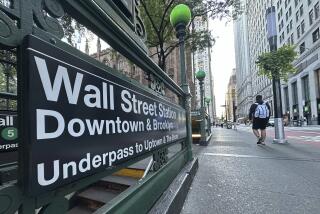Dow Jones busts through 13,000 as bad news becomes good news
- Share via
The traders on Wall Street might be feeling a little nostalgic Friday – the Dow Jones industrial average just crossed 13,000. Again.
There was reason to celebrate when Wall Street’s best-known index first barreled through that number in April 2007. And that record came just six months after the Dow busted through 12,000.
And, we all know what happened shortly after that.
You can’t blame traders for being pretty nervous these days after the financial crisis wiped out investors globally and dragged down a few big banks along with it. There’s no celebrating crossing 13,000 this time on the floor of the New York Stock Exchange.
What’s the next big crisis to slam Wall Street? Citigroup this week raised the probability that Greece will exit the euro to 90% as the nation’s politicians struggle to agree on budget cuts. And, if Europe buckles, the worry is that the pain will spread.
Closer to home, U.S. economic growth slowed further in the second quarter as consumers cut back on spending and businesses curbed their investments. That’s the latest reading coming from the government. Then there’s also angst about the so-called fiscal cliff, the looming tax increases and government spending cuts that could happen at the end of the year.
Despite all this noise, the stock market is thriving. The Dow is up 7% so far this year, and the broader Standard & Poor’s 500 index has notched a 10% increase. And look at the Nasdaq composite – despite Facebook Inc. and other tech stocks taking a beating Friday, it’s still up nearly 14% for the year.
So, you think investors have adopted Alfred E. Neuman’s catch phrase in Mad magazine: “What, me worry?” They are worried. Very worried. And, in some ways, that’s exactly why the stock market is rising.
Bad news is good news these days. This isn’t a new concept for traders and stock investors. The more bad news that pours into the stock market, the more investors begin to anticipate that central banks around the world – including the Federal Reserve in the U.S. – are going to act.
European Central Bank President Mario Draghi said the ECB was ready to do whatever it takes to protect the euro and boost the continent’s economy.
And some economists believe that the Federal Reserve is working on its own stimulus plan to help the sputtering U.S. economy. Policymakers begin a two-day meeting next week when investors might finally find out if the latest economic pressures will be enough to push the Fed into action.
ALSO:
Facebook wrestles with identity crisis
Economic growth slows as consumers pull back
Facebook shares plunging in after-hours trading, now down 9%
European Central Bank chief swears to ‘preserve the euro,’ Dow soars
Follow Joe Bel Bruno on Twitter
More to Read
Inside the business of entertainment
The Wide Shot brings you news, analysis and insights on everything from streaming wars to production — and what it all means for the future.
You may occasionally receive promotional content from the Los Angeles Times.










